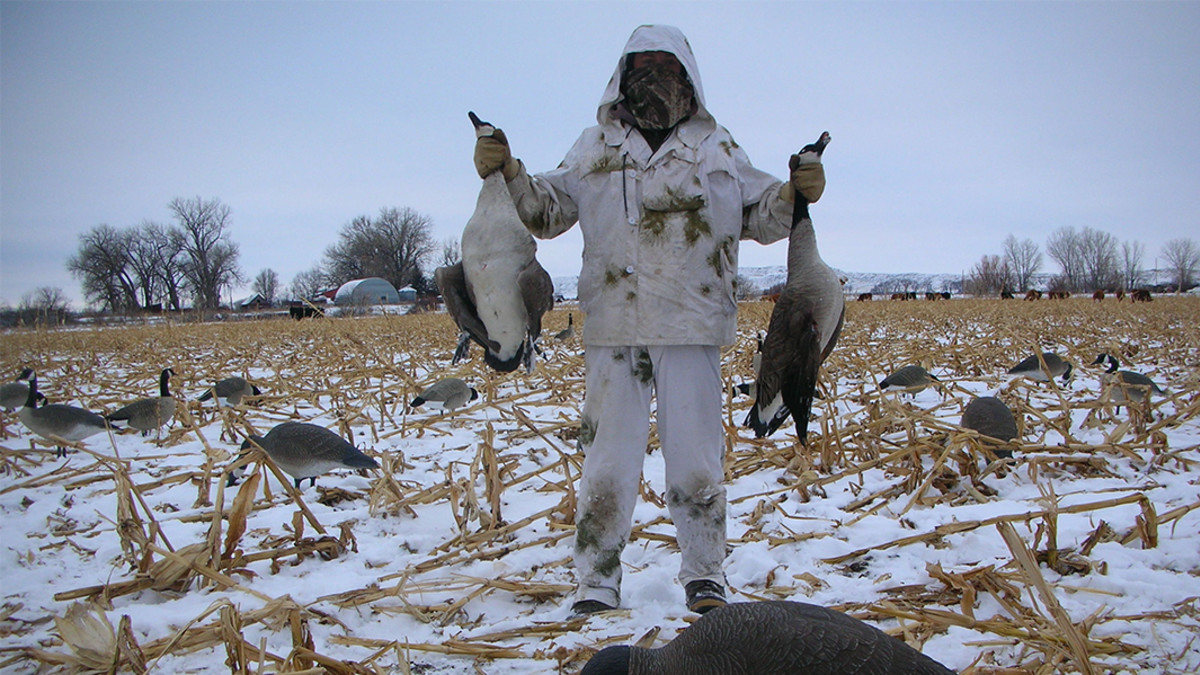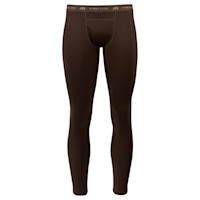
Goose hunting is a favorite pastime of many hunters across the country. Something about a large flock dropping, fast, right toward your decoy spread is exhilarating. While it seems easy at the time the birds start to cup, it is no easy task to to get them to commit.
Geese roost on the water at night and then leave the water early in the morning in order to fly to their feeding areas. They will often return to their roosting areas in the late morning and then spend the middle part of the day resting on the water. In the afternoon, they will head back out for another feeding session and then return to the water again at dusk. During cold weather, they might make additional feeding trips throughout the day.
Decoying and Calling
The most effective way to hunt geese is to ambush them at their feeding grounds with the aid of decoys and calling. The key to this strategy, typically called field hunting, is to locate active feeding grounds. In this case, “active” does not mean that geese were using the area last month or even last week.
Active means that geese were using the area during their most recent feeding session. If you’re hunting on Sunday morning, you want to be where the geese were feeding Saturday night, if you’re hunting Sunday evening, you want to be where the geese were feeding Sunday morning.
While there’s no guarantee that the flocks will use this place again, you might as well operate under the assumption that they will. Beyond selecting the proper field, you should strive to place your decoys in the exact same part of the field that the geese were using. They were there because of something that they liked, and they’ll feel comfortable landing there again.
Stay Concealed
When planning your decoy setup, be mindful of concealment. When pressured, geese become extremely wary. Hunters should take every possible precaution to make sure they are well hidden. They will make multiple overhead passes to scrutinize their landing areas before committing. If anything looks out of the ordinary, they will refuse to touch down no matter how enticing the decoys look and how provocative the calling sounds.
In a picked corn field with lots of stubble lying about, known as a “dirty” field, concealment is made easy because you can use the debris to your advantage by piling it up around your layout blind or weaving it into the cover of your pit blind. But in a field of newly sprouting winter wheat there is little natural cover that can be put into use. In these situations you need to get creative.
Field edges are sometimes suitable for blind placement, but remember that geese don’t like to land near cover that they can’t see over. Irrigation ditches sometimes make great blind locations as long as there’s not a lot of tall vegetation nearby. So do grassy divider strips between fields, so long as there’s no tall vegetation. Snow is an asset as well. A white layout blind on a field of snow might give the hunter all the advantage he needs.
Find What’s Scaring Them
If you are spooking geese, there’s a reason why. The problem might seem very minor, but in the eyes of a wary goose it makes all the difference. Fresh dirt scattered around the edges of an otherwise well-constructed pit blind might be to blame. Corn stubble used to construct a blind in a wheat field might be suspicious enough to scare them off.
So might a wrong colored glove, or a bit of uncovered skin, or a shotgun shell box that’s been left lying outside of the blind. Keep making adjustments until you figure out what’s going wrong. If the last four flocks of geese have spooked without attempting to land, the fifth is going to spook as well unless you correct the issue.
When hunting over decoys for geese, use a 12-gauge shotgun with modified choke. Shoot 3” or 3 ½” shells in either #1 or BB.
Pass Shooting
Ambushing flying birds along their natural travel ways without the aid of decoys, can also be deadly on geese. The strategy is especially useful when you don’t have legal access to the birds’ feeding areas.
The key is to set up in an area where the birds are going to be flying low enough to reach them with a shotgun as they pass overhead, which generally means setting up in a place that’s close to either their roosting area or feeding area so that they’re either still climbing to their cruising altitude or descending from it.
Observation of the birds’ movements should reveal the proper place. As they go about their routines, geese will utilize the aerial equivalent of game trails. Geese leaving a large lake might funnel through a gap in the trees along the water’s edge. Geese following a wide river corridor will funnel through narrow gaps formed where the river valley is “pinched” by natural features. Scouting will also reveal the best times to set up, as geese follow a fairly predictable clock.
Blind construction isn’t nearly as important for pass shooting as it is for decoy hunting, mostly because the birds aren’t looking for trouble as diligently when traveling as they are when preparing to land. You still need to be careful, as heavily hunted birds will veer off course to avoid anything that looks fishy, but you shouldn’t need to actually construct a blind. Just find the best source of cover you can find beneath the center of the travel corridor and then stay low until it’s time to pop up and shoot.
Be careful not to jump up too soon in advance of the birds’ arrival, because geese are masters at evasive flying. They can simultaneously veer to the sides and gain elevation, quickly turning a sure thing into a total failure.
When pass shooting geese, use a 12-gauge shotgun with a modified or full choke. Shoot 3” or 3 ½” shells in BB or BBB.
When to Say, “Take ‘Em!”
There are some days that go perfectly. Birds will respond to calls without any hesitation and fly into your decoys like long lost friends. On days like this, you can wait until the very last second, just before they touch down, to stand up and fire. A retreat to the sky from the cupped-winged and feet-out landing position is that of an aerial backpedal. This makes them easier targets at close range and gives you time to make careful selections of gender.
If it’s been an off day, one where the birds are hesitating before moving in towards the decoys, shooting earlier may be necessary. If mid-range shots have been the daily norm, try to anticipate how close the birds will come before shooting. Try to draw them as close as possible with calling, perhaps allowing them to circle a few times to encourage confidence in the idea of landing. If they start to bail off, shoot before they are out of range.
Of course, some days will be terrible. The birds will not respond to calls, the decoys won’t look inviting, an odd wind will blow, or any number of other things will happen that can create a bad hunt. If you see a bird that is within range, having only had a few shooting opportunities, attempt the long shot.
Sometimes it is better to shoot and miss than not shoot at all and wish you had. But beware the risk of crippling birds. Shots beyond 40 yards should be limited only to experienced wingshooters who understand how to lead birds.







